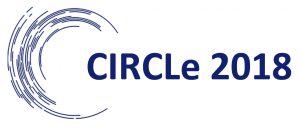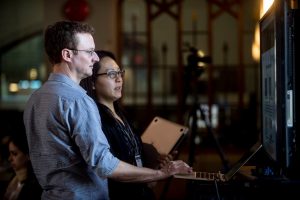Learning through Assessment and the Future of ePortfolios, 3:15 pm to 4:30 pm
- What might institutional learning cultures (academic, universities, colleges) learn from e-portfolio cultures (professional careers, visual arts, performing arts) regarding approaches to assessment?
- What are best practices for creating ‘folio cultures’ for the future of education?
- What are the incentives, benefits and challenges for faculty, students and programs to use e-portfolios or personal web spaces?
- What can we do to get more value from these digital tools?
TABLE 1 DISCUSSION (Pedagogy & Reflection Group):
- Assessment:
- Assessment for eportfolio contest: Reflection on the artifact itself, design elements (depending on the course; could fit with a visual arts course)
- Would students w/o design background be disadvantaged? But our society is becoming increasingly visual so this is a skill that maybe students should develop.
- If there is a template that is flexible enough then students don’t have to have really strong design skills but can still make it look good.
- Discussing value of settings that allow students to choose what gets shown publicly and what doesn’t. Useful to have ability to show some things just to instructors.
- Be mindful and stay wary of the privacy of students and how they choose to represent themselves online
- ePortfolios can help students to draw links between things they do in the classroom and outside of the university, showing how their skills and expertise and interests cross these various contexts
- A platform itself can guide students towards making such connections—e.g., the new Arts portfolio platform encourages students to focus on skills and then link up to various courses and activities outside of university
- We talk a lot about reflection; what exactly does that mean in an eportfolio context?
- Why you’ve done what you’ve done, assessing it, thinking about how you can improve—metacognition on learning to see what you’ve learned and how, and what more you would like to learn
- Integration of work in a course with other courses and activities outside the university—how my skills have developed through these different activities
- Why did I do this, what inspired me, what motivated me to do this particular project?
- What challenges did I run into and how did I address them? You can’t share this sort of thing in your final project—it should be polished.
- Can go through the steps of a project to get to the final product.
- Build reflection thinking early– introduce reflection prompts and questions to students early and transition into sharing that on ePortfolio mediums
TABLE 2 DISCUSSION (Pedagogy & Instruction Group):
How we can create eFolio cultures?
- Creating/reactivating communities of practice but making it reasonable in terms of time schedules
- Ability to learn from others and not operate in silos
- Reactivating the UBC Community of Practice for portfolios may be helpful for campus-wide sharing. Lucas Wright ran this in 2013 and kele worked on this in the early 2000s
Meeting a couple of times a year would be helpful, after the TLEF is wrapped up.
- UBC Education – eportfolio was mandatory for a while, but no longer — developed to match 8 standards students needed to get certified to teach in BC
- Need to know the culture and particular context at the time to build a culture
- K-12 may force us to be more responsive to ePortfolios
Challenges with assessment?
- Get students to self-assess on a rubric/framework that is provided. Declare which objectives or outcomes they’ve achieved. Ask students to explain how their artifacts reflect competencies
- The issue is that scholarships, fellowship, etc. tied to grades, so instructors feel they need to give grades so students are eligible for these awards
- Some faculty don’t even know what are the learning outcomes for their department
- We need to be accountable to our students and for accreditation when applicable
- Suggestion based on past system at Royal Roads University where program objectives became known as numbers and learning outcomes for courses were recognized as letters.
TABLE 3 DISCUSSION (Professional Identity Group):
Points on Assessment from Tracy Penny Light:
- Context: where is the learning occurring?
- Stakeholders: who conducts the assessment? Who is interested in the results? How is assessment defined by all stakeholders?
- What is being assessed: Is learning the key focus? Who defines what constitutes evidence of learning?
- How is assessment happening: Is the ePortfolio the only source of evidence?
Comments from group discussion:
Q: How can we use assessment to support learner autonomy? Do we showcase written drafts or narrate them, or only choose a showcase piece?
TABLE 4 DISCUSSION (Programs & Assessment Group):
Points on Assessment from Tracy Penny Light:
- Context: where is the learning occurring?
- Stakeholders: who conducts the assessment? Who is interested in the results? How is assessment defined by all stakeholders?
- What is being assessed: Is learning the key focus? Who defines what constitutes evidence of learning?
- How is assessment happening: Is the ePortfolio the only source of evidence?
Comments from group discussion:
- Every form of an ePortfolio has the potential to alienate some users, not one solution fits all.
- In Education the platform was deployed without connection to classes, evaluation, or assignments.
- The Buy-in of faculty is harder in larger schools.

